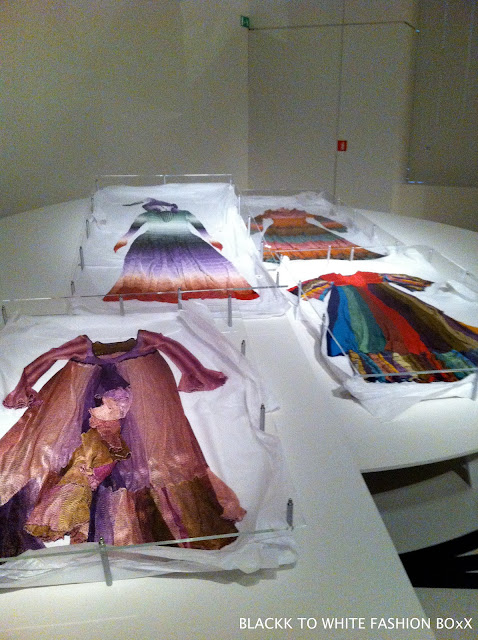VISIT MY NEW WEBSITE www.mywhiteblackfashionbox.com
A few week ago I took the route to Antwerp, the fashion city of Belgium, where I visited the Fashion Museum of Antwerp. This time the museum presented an exhibition about knitwear.
I was so excited to learn about
The wide variety of knitted garments from accross the last centuries;
Knitwear's popularity both on an off the catwalk;
The status of relationship between knitwear and fashion;
The knitted designs of top designers (like Vivienne Westwood, Sonia Rykiel, Alexander McQueen etc).
I would like to share some interesting information here. I hope you enjoy it!
The Fashion Museum of Antwerp took me in the spirit of knitwear at the single moment I entered: At the entrance to the museum a large knitwork and a large spools of wool with print on the wall of a knitwear.
Ann Salens
Ann Salens the Antwerp designer, accredited for her colourful crocheted Bird of Paradise dresses:
Machine-knits
In the 16th century, William Lee invented the hand-operated knitting machine that was used for knitting hosiery (= socks) for the next two centuries.
 |
Knitting machine invented by William Lee |
Thanks to technically innovated knitting machines among several centuries, it was possible to produce more, less expensive and more fashionable knitwear. By the end of the 19th century, artificial silk and nylon had been developed. The nylon of Du Pont de Nemours, became common.
 |
Nylon socks in original packaging by Du Pont de Nemours |
|
Knitted lingerie
For a long time, knitwear has been also used for sleepwear and undergarments (sleeping caps, slips, pyjamas).
Sportive knitwear
In the 20th century the 'new woman sporting lifestyle' began to develop. Designers such as Gabrielle Chanel and Jean Patou were visionary in their combinations of sportive woven fabrics and fashionable designs for the emancipated woman. As a result, sports and fashion now became permanently linked.
At the 1912 Olympic Games, women first took part in the swimming competitions. This official Olympian seal of approval of swiming as an appropriate sport for women worked as a catalyst for the development of a modern and practical swimsuit.
The Edwardian two-piece bathing costumes were replaced in the 1920s by knitted one-piece swimming suits. The new swimsuits were more suitable for activities in the water and were perceived as "The suit that changed bathing to swimming". The modern woman wearing modern swimsuit became a true icon of the times that even the media stated that 'Every woman who wants to be "in the swim" of fashion, simply must posses a knitted bathing suit'.
 |
Two-piece bathing costumes
 |
Knitted one-piece swimming suits |
|
Knitted Status Symbols |
Angelo Figus created knitted versions of various status symbols, ranging from handbags from knitted Hermès, Vuitton and Chanel handbag to Louboutin shoes and Burberry trench coats, fruits, flowers, etc. His intention was to demonstrate a strong vision of a world in which everything was knitted.
 |
Supermarket of Style by Angelo Figus |
 |
Knitted Gucci Shoes by Angelo Figus
|
Sculptural knitwear
Three-dimensional experiments by designers including Sandra Backlund, Maison Martin Margiela have resulted in impressive sihouettes. Especially amongst the young designers, we see the return of natural materials and seemingly primitive threads that are knitted with awls as thick as broomsticks.
 |
Crocheted and hand-knit dress by Sandra Backlund |
|
French Read-to-wear
France is the land where countless knitwear evolutions and revolutions have taken place. Designers built a bridge between sporting knitwear and both ready-to-wear and haute couture.
 |
Silk dress with crochetted flowers by Chanel |
|
 |
Woollen dress made by Jean Paul Gaultier as gift for the 40th anniversary of Sonia Rykiel fashion house
British classics
|
The British woollen industry is still today one of the most important in Europe. The knitting machine was invented by the Englishman, William Lee, and as the birthplace of the Industrial Revoluion, Great Britain set the stage for many revolutionary steps that would take in the knitting industry. Protests against the mechanization and cultural rehabilitation of the craft of knitting, brought a more highly appreciation of handcraft than the advanced technology of machine-knit clothing. The intermingling of contemporary and past, classic with punk, is never far away in knitted fashions from Great Britain.
 |
Cotton ensemble including a top and trousers with decorative stitches by Peter Pilotto
|
|
Italian luxury industry
Italy is the most important manufacturing nation for knitted fabrics for the high fashion world. Partly thanks to Italian inclinations towards comfortable luxury, Italy has had a blossoming knitwear industry ever since the 1950s, thanks to manufacturing centres of quality materials and luxury fashion houses that make use of knitted fabrics in all their forms.
 |
Cotton dress and hairband, earrings, bracelets by Missoni |
|
 |
Hand-knitted evening dress by Gianfranco Ferré
|
Unravel
The so-called unravelling is the non-knitting of individual stitches, whereby large holes are created, which is a true deconstruction of knitted fabrics, Rei Kawakubo states: 'machines that make fabric are more and more able to produce uniform, flawless textures. I ilke it when something is not perfect. Hand-weaving is the best way to achieve this, but since this isn't always possible, we loosen a screw on the machines here and there so they can't do exactly as they are supposed to.'

Cotton dress with open knitwork by Mark Fast
|
|
 |
Woollen dress with open knitwork alternated with floating threads by Iben Höj |
|


















No comments:
Post a Comment